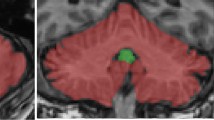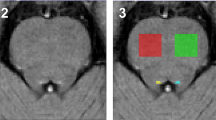Abstract
The International Cooperative Ataxia Rating Scale (ICARS) is a 100-point semiquantitative scale designed primarily to assess cerebellar dysfunction. However, little is known of the metric properties of this scale. We assessed the ICARS by rating the severity of cerebellar dysfunction in 27 patients with spinocerebellar ataxias (SCA), three patients with sporadic olivopontocerebellar ataxia and 24 healthy control subjects. [18F]-fluorodeoxyglucose (FDG) positron emission tomography (PET) study was also performed on each subject. The statistical parametric mapping analyses revealed a significant correlation between the ICARS scores and functional impairment of the frontal regions within SCA patients. The glucose metabolism in the cerebellum, thalamus and caudate nucleus had significant differences between SCA patients and healthy control subjects. The results suggested that the clinical severity of SCA patients correlated with the functional impairment in the frontal regions, the targets of cerebellar efferent projections.
Similar content being viewed by others
References
Brenneis C, Bosch SM, Schocke M, Wenning GK, Poewe W (2003) Atrophy pattern in SCA2 determined by voxel-based morphometry. Neuroreport 14:1799–1802
Cui DM, Yan YJ, Lynch JC (2003) Pursuit subregion of the frontal eye field projects to the caudate nucleus in monkeys. J Neurophysiol 89:2678–2684
Day BL, Thompson PD, Harding AE, Marsden CD (1998) Influence of vision on upper limb reaching movements in patients with cerebellar ataxia. Brain 121:357–372
DeLong MR, Alexander GE, Georgopoulos AP, Crutcher MD, Mitchell SJ, Richardson RT (1984) Role of basal ganglia in limb movements. Hum Neurobiol 235–244
Deniau JM, Kita H, Kitai ST (1992) Patterns of termination of cerebellar and basal ganglia efferents in the rat thalamus. Strictly segregated and partly overlapping projections. Neurosci Lett 144:202–206
Ettinger U, Kumari V, Chitnis XA, Corr PJ, Sumich AL, Rabe-Hesketh S, Crawford TJ, Sharma T (2002) Relationship between brain structure and saccadic eye movements in healthy humans. Neurosci Lett 328:225–228
Friston KJ, Holmes AP, Worsley KJ, Poline JP, Firith CD, Frackowiak RSJ (1995) Statistical parametric maps in functional imaging: a general linear approach. Hum Brain Mapp 2:189–210
Furman JMR, Baloh RW, Yee RD (1986) Eye movement abnormalities in a family with cerebellar vermian atrophy. Acta Otolaryngol 101:371–377
Fukuyama H, Ouchi Y, Matsuzaki S, Nagahama Y, Yamauchi H, Ogawa M, Kimura J, Shibasaki H (1997) Brain functional activity during gait in normal subjects: a SPECT study. Neurosci Lett 228:183–186
Gerardin E, Lehericy S, Pochon JB, Tezenas du Montcel S, Mangin JF, Poupon F, Agid Y, Le Bihan D, Marsault C (2003) Foot, hand, face and eye representation in the human striatum. Cereb Cortex 13:162–169
Inagaki A, Iida A, Matsubara M, Inagaki H (2005) Positron emission tomography and magnetic resonance imaging in spinocerebellar ataxia type 2: a study of symptomatic and asymptomatic individuals. Eur J Neurol 12:725–8
Jeffries KJ, Fritz JB, Braun AR (2003) Words in melody: an H2 15O PET study of brain activation during singing and speaking. Neuroreport 14:749–754
Kim YK, Lee DS, Lee SK, Kim SK, Chung CK, Chang KH, Choi KY, Chung JK, Lee MC (2003) Differential features of metabolic abnormalities between medial and lateral temporal lobe epilepsy: quantitative analysis of (18)FFDG PET using SPM. J Nucl Med 44:1006–1012
Marien P, Engelborghs S, Fabbro F, De Deyn PP (2001) The lateralized linguistic cerebellum: a review and a new hypothesis. Brain Lang 79:580–600
Middleton FA, Strick PL (1997) Cerebellar output channels. Int Rev Neurobiol 41:61–82
Miyai I, Tanabe HC, Sase I, Eda H, Oda I, Konishi I, Tsunazawa Y, Suzuki T, Yanagida T, Kubota K (2001) Cortical mapping of gait in humans: a near-infrared spectroscopic topography study. Neuroimage 14:1186–1192
Riecker A, Ackermann H, Wildgruber D, Dogil G, Grodd W (2000) Opposite hemispheric lateralization effects during speaking and singing at motor cortex, insula and cerebellum. Neuroreport 11:1997–2000
Rub U, Del Turco D, Del Tredici K, de Vos RA, Brunt ER, Reifenberger G, Seifried C, Schultz C, Auburger G, Braak H. (2003) Thalamic involvement in a spinocerebellar ataxia type 2 (SCA2) and a spinocerebellar ataxia type 3 (SCA3) patient, and its clinical relevance. Brain 126:2257–72
Salmon E, Collette F, Degueldre C, Lemaire C, Franck G (2000) Voxel-based analysis of confounding effects of age and dementia severity on cerebral metabolism in Alzheimer’s disease. Hum Brain Mapp 10:39–48
Shibasaki H, Fukuyama H, Hanakawa T (2004) Neural control mechanisms for normal versus parkinsonian gait. Prog Brain Res 143:199–205
Soong BW, Liu RS (1998) Positron emission tomography in asymptomatic gene carriers of Machado-Joseph disease. J Neurol Neurosurg Psychiatry 64:499–504
Talairach J, Tournoux P (1988) Coplanar stereotaxic atlas of the human brain 3-dimensional proportional system: an approach to cerebral imaging. New York, Thiemen Medical
Thach WT, Bastian AJ (2004) Role of the cerebellum in the control and adaptation of gait in health and disease. Prog Brain Res 143:353–366
Thier P, Dicke PW, Haas R, Thielert CD, Catz N (2002) The role of the oculomotor vermis in the control of saccadic eye movements. Ann N Y Acad Sci 978:50–62
Thier P, Haarmeier T, Treue S, Barash S (1999) Absence of a common functional denominator of visual disturbances in cerebellar disease. Brain 122:2133–2146
Trouillas P, Takayanagi T, Hallett M, Currier RD, Subramony SH, Wessel K, Bryer A, Diener HC, Massaquoi S, Gomez CM, Coutinho P, Ben Hamida M, Campanella G, Filla A, Schut L, Timann D, Honnorat J, Nighoghossian N, Manyam B (1997) International Cooperative Ataxia Rating Scale for pharmacological assessment of the cerebellar syndrome. The Ataxia Neuropharmacology Committee of the World Federation of Neurology. J Neurol Sci 145:205–211
Watanabe K, Lauwereyns J, Hikosaka O (2003) Neural correlates of rewarded and unrewarded eye movements in the primate caudate nucleus. J Neurosci 5(23):10052–10057
Author information
Authors and Affiliations
Corresponding author
Rights and permissions
About this article
Cite this article
Wang, PS., Liu, RS., Yang, BH. et al. Topographic brain mapping of the international cooperative ataxia rating scale. J Neurol 254, 722–728 (2007). https://doi.org/10.1007/s00415-006-0310-0
Received:
Revised:
Accepted:
Published:
Issue Date:
DOI: https://doi.org/10.1007/s00415-006-0310-0




